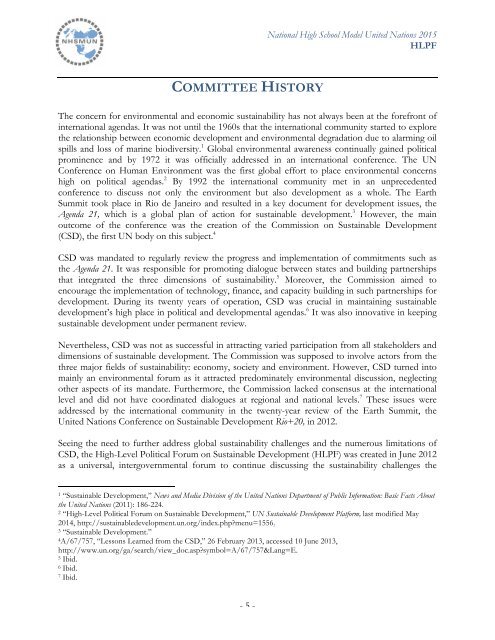d5MrHv
d5MrHv
d5MrHv
You also want an ePaper? Increase the reach of your titles
YUMPU automatically turns print PDFs into web optimized ePapers that Google loves.
National High School Model United Nations 2015<br />
HLPF<br />
COMMITTEE HISTORY<br />
The concern for environmental and economic sustainability has not always been at the forefront of<br />
international agendas. It was not until the 1960s that the international community started to explore<br />
the relationship between economic development and environmental degradation due to alarming oil<br />
spills and loss of marine biodiversity. 1 Global environmental awareness continually gained political<br />
prominence and by 1972 it was officially addressed in an international conference. The UN<br />
Conference on Human Environment was the first global effort to place environmental concerns<br />
high on political agendas. 2 By 1992 the international community met in an unprecedented<br />
conference to discuss not only the environment but also development as a whole. The Earth<br />
Summit took place in Rio de Janeiro and resulted in a key document for development issues, the<br />
Agenda 21, which is a global plan of action for sustainable development. 3 However, the main<br />
outcome of the conference was the creation of the Commission on Sustainable Development<br />
(CSD), the first UN body on this subject. 4<br />
CSD was mandated to regularly review the progress and implementation of commitments such as<br />
the Agenda 21. It was responsible for promoting dialogue between states and building partnerships<br />
that integrated the three dimensions of sustainability. 5 Moreover, the Commission aimed to<br />
encourage the implementation of technology, finance, and capacity building in such partnerships for<br />
development. During its twenty years of operation, CSD was crucial in maintaining sustainable<br />
development’s high place in political and developmental agendas. 6 It was also innovative in keeping<br />
sustainable development under permanent review.<br />
Nevertheless, CSD was not as successful in attracting varied participation from all stakeholders and<br />
dimensions of sustainable development. The Commission was supposed to involve actors from the<br />
three major fields of sustainability: economy, society and environment. However, CSD turned into<br />
mainly an environmental forum as it attracted predominately environmental discussion, neglecting<br />
other aspects of its mandate. Furthermore, the Commission lacked consensus at the international<br />
level and did not have coordinated dialogues at regional and national levels. 7 These issues were<br />
addressed by the international community in the twenty-year review of the Earth Summit, the<br />
United Nations Conference on Sustainable Development Rio+20, in 2012.<br />
Seeing the need to further address global sustainability challenges and the numerous limitations of<br />
CSD, the High-Level Political Forum on Sustainable Development (HLPF) was created in June 2012<br />
as a universal, intergovernmental forum to continue discussing the sustainability challenges the<br />
!!!!!!!!!!!!!!!!!!!!!!!!!!!!!!!!!!!!!!!!!!!!!!!!!!!!!!!!!!!!<br />
1 “Sustainable Development,” News and Media Division of the United Nations Department of Public Information: Basic Facts About<br />
the United Nations (2011): 186-224.<br />
2 “High-Level Political Forum on Sustainable Development,” UN Sustainable Development Platform, last modified May<br />
2014, http://sustainabledevelopment.un.org/index.php?menu=1556.<br />
3 “Sustainable Development.”<br />
4A/67/757, “Lessons Learned from the CSD,” 26 February 2013, accessed 10 June 2013,<br />
http://www.un.org/ga/search/view_doc.asp?symbol=A/67/757&Lang=E.<br />
5 Ibid.<br />
6 Ibid.<br />
7 Ibid.<br />
- 5 -


